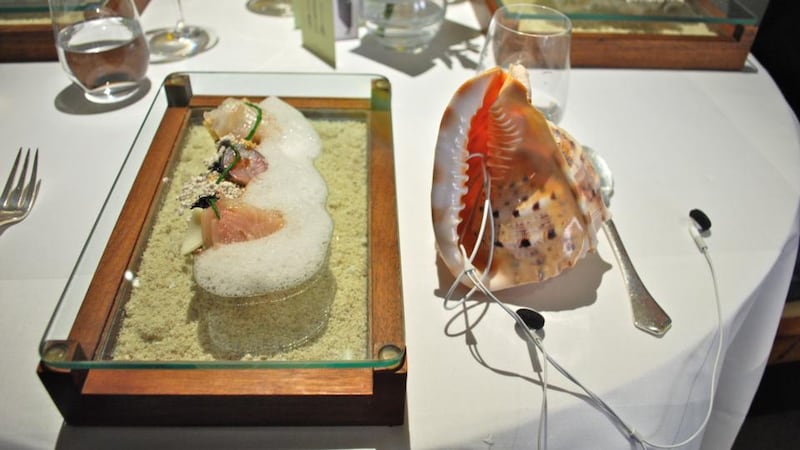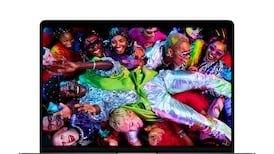A succulent piece of monkfish in a tasty sauce rests on the plate. You cut into the thick and moist flesh, place it in your mouth, and savour the distinct taste.
In fact, it isn’t monkfish, but a cheaper, less over-fished whitefish. You don’t notice, though, because your virtual-reality headset and technology-enhanced cutlery are delivering the full monkfish taste, smell and appearance.
That may be a potential meal of the future, according to neuroscientist Charles Spence, head of the Crossmodal Research Laboratory in the Department of Experimental Psychology at Oxford University. Spence's research on the senses, particularly taste, and work with renowned, technology-curious chefs such as Heston Blumenthal, has taken him to the cutting edge of gastronomy.


“In the past 30 years, it’s all been technology in the kitchen – these new machines, new compounds,” he says. “Maybe after 30 years of that, it’s time for technology to come to the front of the house.”
Spence, who will give a talk next week at the annual Digital Biscuit film and technology event in Dublin, is fascinated by the often surprising ways our senses overlap and collaborate.
“I’ve always been interested in the senses,” he says, noting that initially, he focused on hearing and vision, then touch. “And then, over the years, I kind of got roped in to doing smell and then taste. And then somebody put me in touch with Heston Blumental . . . ” And the rest is gastronomic history.
Blumenthal, familiar to television viewers from a variety of programmes, is the best known purveyor of “molecular” gastronomy, artfully combining science, technology and food at his famous Fat Duck restaurant in Bray in the UK.
Flavour research
Taste, Spence says, is perhaps the least researched and understood sense.
“Studying flavour can be really difficult because people adapt and get full up really quickly, so you can’t give them a load of different things to taste. So flavour research tends to be quite slow. Contrast that with hearing and vision. You can stick someone in front of a computer and leave them there for an hour and they’ll do a thousand trials or responses. You learn things much more rapidly.”
Just as the brain puts together hearing and vision (we look for the movement of lips to match the sound we hear, for example), it probably also puts together smell and flavour and, Spence says, even more senses.
We all think we experience taste through our mouths, he says, but the brain is known to be influenced by a combination of the senses. He notes the “ventriloquist effect’, in which the brain will fit sounds to lip movement, even if out of sync on television, or in a dubbed foreign film.
“Our brain also kind of ventriloquises flavour from the nose – floral, meaty – and gives it to us as if we are experiencing it through our mouth,” he says.
Exploring such connections “kind of gave me a jump-start on all those people who’d spent a decade looking at flavour through that more traditional, slow process.”
A breakthrough for Spence was considering sound and flavour.
“Sound is a forgotten flavour sense. No one was interested. But then it turns out it’s much more important than we realised: crispy, crunchy, carbonated, creamy.”
He produced a research paper on sound and crisps – “you could see just how important sound was to your experience of crunch” – and consequently won a coveted Ignobel prize (the tongue-in-cheek counter to the Nobels) in 2008 for work on “the sonic crisp”.
That has led to work considering how ambient sounds influences flavour.
He cites Blumental’s famous “Taste of the Sea” dish, in which the meal arrives on a plate, accompanied by a conch shell in which sits an iPod and headphones. “You hear the sound of the sea as you eat the dish.”
Adding sound encourages diners to focus more on the food itself and the complete eating experience, rather than the environment of the restaurant, conversation, or, in that new phenomenon, distractedly looking at their own mobile phones while at the table.
But sound is not just for high-end dining. “We’re also working with apps that match music to what you’re eating – your ice cream, your wine, your tea.”
A London restaurant is using an app to add sound to what you eat, to influence the way it tastes, Spence says. British Airways has launched a programme called Sonic Seasonings, which pairs a special dining soundtrack to in-flight meals on long-haul flights. It's "the first time a big organisation has tried out" the concept, he says.
There’s also the Concerto app, utilised by Häagen-Dazs.
“You scan the lid and hear and see musicians playing music. Once the musicians have played, then supposedly your ice cream is ready to scoop.”
Jelly Baby effect
Quirky apps and devices are coming out of the Far East, such as the “Mouth Jockey” headset, which pairs a matching sound to a food. In one paper, Spence and his co-author jokingly suggest screams to accompany eating a handful of Jelly Babies, but that might be overly alarming.
Spence’s own lab is working with augmented reality glasses, such as Oculus Rift headsets. “You look through the headset, which actually changes the appearance of what you’re eating. So you think you’re eating one type of fish when you’re eating something else.”
This might be useful in a future where some foods will become increasingly costly or even extinct. “It could recreate lost flavours. But you can also imagine a dinner party where everyone has these headsets on, and it could be very playful.”
There are other possibilities for innovation, Spence says.
“Cutlery hasn’t evolved. Contrast that with how much excitement there is in the food itself now, thanks to experimentation, or the change we’ve seen in the plates on which the food is served – slates, flower pots. What could cutlery be? What do you want to get out of it, as the interface between you and the food?”
Plates still have room to evolve. A tablet computer might make a nice plate that could visually and musically enhance food. At the London launch of their recent book, The Perfect Meal, Spence and co-author Betina Piqueras-Fiszman served an amuse-bouche on iPads, with a shimmering background on the screen.
And Phillips Design has developed multisensory plateware that lights up, plays music and is being used in a high-end restaurant, he says.
Spence hopes the overlap between technology and flavour doesn’t remain exclusive to costly fine dining.
“The question is, how can you take that and capture it and bring it into the home environment? The way that is going to happen, I think, is through mobile technology, through QR codes, through scannable packaging. And hopefully then there’ll be a role for neuropsychologists like myself, to advise about what particular combinations might work best,” he laughs.
“But I think it might first enhance the high end. The hope is to experiment there and then think about how to break the mass market. It has to be about giving [consumers] a genuine sensory enhancement. That’s the goal.”
What some of the finest chefs are doing should be recognised as a unique type of art, he thinks. “Edible can be artistic.”
“So much of what is happening in top-end restaurants . . . it can’t be just about the food” when the meal is so expensive. “There’s a huge multisensual, curated experience.”
A story in food
The possible storytelling element will ring true for film-makers at Digital Biscuit.
“It’s both the experiential and the multisensory experience that maintains a link with storytelling,” Spence says. “Some of the chefs will say, you know, you can’t just have 20 knock-out dishes in a row. You need about five.
“So you have to modulate the succession of dishes over time, and it may be much the same way as a film or theatre director might think about that – having moments of high tension and of relaxation. To translate, then, to a restaurant setting is kind of an exciting space.”
All of which makes for an interesting career.
“For me, it was kind of accidental, but I ended up in a place that is really important and fun. I think psychology can help with the current revolution with culinary practice and design.”
The Digital Biscuit film and technology forum will be held at the Science Gallery, Dublin from January 28th to 30th. Go to digitalbiscuit.ie











